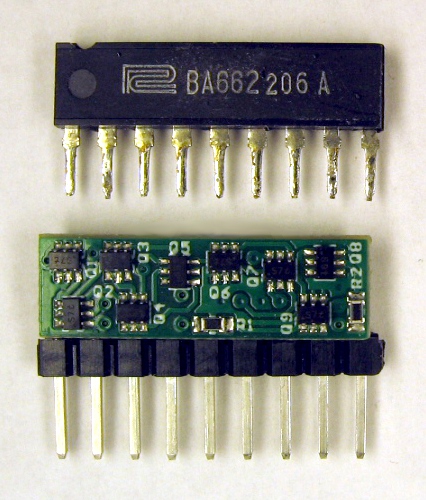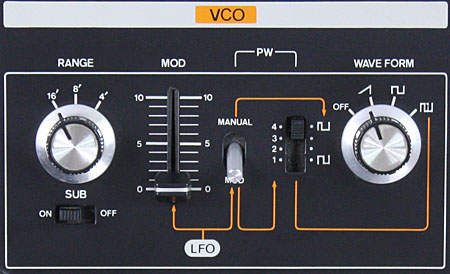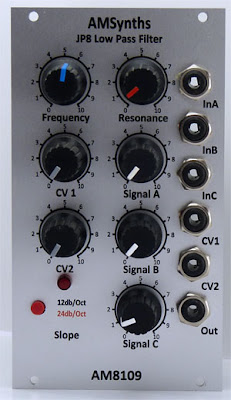
"Newsletter March 2013
Latest News: At last a new AMSynths newsletter after nearly 6 months! We can only say we have been really busy....here is the latest news and plans for 2013.
Xmas was a busy time and we shipped over 25 modules to customers and completed the design of the AM8328 Mirage Filter - which has been shipping since early January. Customer demand has increased in 2013 , so we are we have restarted our sales to the SDIY market with panels, and blank PCB's now in stock and on sale in the online store. We have also added a free online reservation system here from the web store, so customers can be sure they will get a module. Production volumes have slipped back in February due to various holidays and a busy day job, but March and April will see more modules shipping and new products arriving.
Module Plans
The popular AM8012, AM8075, AM8071 and AM8109 filter modules are in production but there is a queue of reservations to satisfy before they will appear in the online store in large volumes. The new AM8328 Miarge Filter will see another 10 modules built in March, along with the arrival of the AM8044 VCF & VCA which has cleared testing and is going into production. It is the first module we have implemented with both a filter and final stage VCA, so all it needs is a dual ADSR and dual VCO to create some fantastic sounds. A special Dave Rossum tribute VCF, the AM8040 will be launched as a PCB sets for the SDIY market initially. It will have both 2 and 4 pole modes, and can use either a rare SSM2040 chip or the HM2040 replica. If there is sufficient customer demand it will be introduced as a completed EuroRack module based on the HM2040 chip, it will have the same panel design as an AM8109 JP8 VCF and provides the sounds of the SCI Prophet 5 early models as well as the original E-mu Systems Audity 16 voice synthesizer.
The versatile dual SVF filter, the AM8060SE, is completing it's first production PCB build this weekend and if this goes ok we can start manufacturing modules for a 24 March 2013 launch. I have put some photos of the prototype on the web store, and I will add some new demos soon. The Dual ADSR AM8140 is the other product launch for late March, with a first production build to check everything is ok. Then there is the AM8005 Diode VCF to finalise on 12V and get into production, I know alot of customers are waiting on this module, so it is top of the list!
The dual VCO's remain in development with the ARP version (AM8027) about to go into a final production stage, the reason for the delay is we had to find some switched vertical jack sockets that fit the design, which we now have. The JP8 Dual VCO is at design stagee with a few more months work to get all the extra features loaded, such as the quantiszed picth knob (using a PIC) and the in-built analog LFO. The VCO designs have been switched to dual rather than single to reduce the overall costs of 2 VCO's, which everyone needs.
A set of new modules planned for 2H2013 are waiting on the arrival of the right log response vertical pots from Small Bear. This includes a dual linear and expo response VCA (AM8164) and the AM83272 Ambient VCF (using the CEM3372). The AM8706 LFO can now more forward with the right vertical jack sockets, so expect this module and the AM8019 ARP style VCA to appear by mid 2013.
Customer Feedback
AMSynths really appreciates customer feedback and ideas. Just send an email to me at sales@amsynths.co.uk. The recently launched AM8328 Mirage Filter was all down to one of our customers, Adam, asking us to make this module using CEM3328 chips. This had led onto the idea of a Key Track pot on some new modules (AM8040) which enables filter cutoff to be varied up or down by the note played on the keyboard. So do let me know of the features and modules you would like to see. For example we have new ideas floating around at AMSynths HQ, for an audio mixer, ring modulator and noise source module, which kinda replicates the middle of an Roland SH-5 (AM8002) and a programmable ADSR with 64 patches which can be voltage controlled (AM8056). And if anybody on the list writes coolt DSP code, we would love to launch a Z-plane digital filter.
Future Plans
Our biggest problem is manufacturing enough modules to meet the increasing customer demand, and that is before we do any press marketing or shows! So we are completeing reaseach into larger scale assembly and manufacturing for some modules, to see what it does to the margins and retail prices. AMSynths have launched a partnership with SynthCube, where you buy my designs in MOTM, FracRac and other non-Euro formats. The AM4023 2 pole OTA filter is the first SynthCube module to hit production, but many more will follow in 2013. The web store will move to a new platform in late 2013 to provide a better presentation and more features. We will continue to operate 2 web sites, one as a secure store and one as a blog and information portal. And Finally, many thanks to all our customer for purchasing AMSynths products and your patience in trying to buy more. I will get more newsletters out this year, timed with product launches."

Left: "
AM8328 VCF PCB Set
This is a PCB kit for the AM8328 Mirage VCF which enables you to build a EuroRack Module with a 16-pin 12V Doepfer Bus power connector. It may also work on 15V but I have not tried it out.
The AM8328 is a 4 pole Low Pass Filter that uses the CEM3328 filter chip to produce a amazing sounding VCF.
Project Notes:
Kit Components
The AM8328 PCB kit contains:
AM8328 POT PCB (ROHS compliant, blue solder mask).
AM8328 VCF PCB (ROHS compliant, blue solder mask).
You can also purchase Pot Brackets (x7), Jack PCB and an AMSynths factory AM8328 EuroRack panel.
Kits EXCLUDE the CEM3328 chip. You will need to locate one on eBay. An Ensoniq Mirage has 8x inside."
Above: "
AM8328 The Mirage Filter
This module is based around the CEM3328 4-pole Low Pass Filter chip that was released in 1984, as one of the last filter chips and with some great features. It has differential signal inputs, an accurate exponential scale over 14 octaves and voltage controlled resonance. It has a unqiue feature, the signal level is automatically increased as the resonance goes up, thereby avoiding the usual signal level dropping off as resonance comes in. The CEM3328 was late onto the analog stage, just before digital filters appeared, so it only made it into the BIT01 and Ensoniq Mirage (and a few drum machines). So this chip has never really seen action, and was never under analog pot control, just lonely digital parameter access! In the Mirage it was not even allowed to oscillate…..We just love giving it a new lease of life in a new analog module!"
 "NEW SYNTH ALERT: Here is the aluminium panel for the AMSynths DIODE-01 analog synthesizer. It is an accurate replica of the Roland System 101 with its diode ladder filter, combined with the extra features of the 102 (Ring Mod, S&H). The prototype will be ready in October. What do you think?"
"NEW SYNTH ALERT: Here is the aluminium panel for the AMSynths DIODE-01 analog synthesizer. It is an accurate replica of the Roland System 101 with its diode ladder filter, combined with the extra features of the 102 (Ring Mod, S&H). The prototype will be ready in October. What do you think?"































































